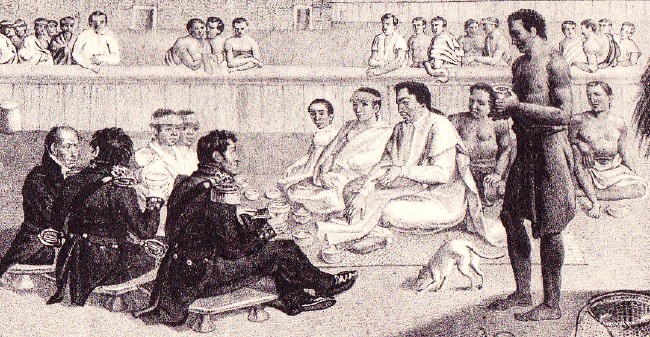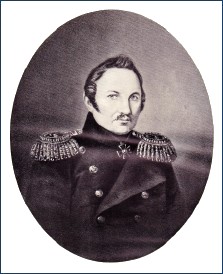|
The
voyage of captain Bellingshausen to the Antarctic seas 1819-1821 /
translated from the Russian ; edited by Frank Debenham. -
London : The Hakluyt society, 1945. - 2 vol.
(XXX-474 p.-36 pl.-[15] cartes) ;
23 cm. -
(Second Series, XCI-XCII).
|
|
The
highest authority on the history of Antarctic exploration, Dr Hugh
Robert Mill, says … that the voyage of Captain
Bellingshausen
was « one of the greatest Antarctic expeditions on
record,
well worthy of being placed beside that of Cook ».
☐ Frank
Debenham, Introduction,
p. XI |
Bellingshausen
était originaire d'une famille d'ascendance germanique
installée sur l'île d'Ösel (aujourd'hui
Saaremaa en
Estonie) — où il est né en 1779.
Diplômé de l'Académie navale de
Kronstadt, il a participé, comme cinquième
officier,
à la première circumnavigation russe sous les
ordres d'Adam
von Krusenstern
(1803-1806). Comme la marine russe dans son ensemble, et comme
Krusenstern en particulier, Bellingshausen admirait la marine
britannique et le capitaine Cook.
En 1819, le marquis de
Traversay 1
— Ministre en charge de la marine
russe — confie
au baron Bellingshausen le commandement et la responsabilité
d'une exploration approfondie
dans le Pacifique Sud et en Antarctique, pour tenter
d'établir l'existence du continent dont Cook
s'était
approché sans avoir pu apporter
la preuve définitive de son existence. En
complément de
cet objectif principal Bellingshausen était
également
chargé de reconnaître des îles et terres
nouvelles,
de vérifier les informations des navigateurs l'ayant
précédé dans le Pacifique et de
contribuer
à la cartographie d'archipels réputés
dangereux ;
à ce titre il mènera, avant de retourner vers
l'hémisphère nord, une investigation approfondie
des
Tuamotu.
Pas plus
que Cook, Bellingshausen ne put confirmer l'existence d'un continent
autour du Pôle Sud :
“ By an unkind fate neither
Cook nor Bellingshausen, in spite of all
their gallantry and persistence, was to prove that what had been
guessed at on the slenderest grounds did in fact exist, a very large
and indeed the highest of all the continents, hidden behind the
barriers of ice which turned them back from their repeated assaults.
“ Perhaps
Bellingshausen's was the unkinder cut of the two since
(…) he did view the continent but did not recognize it as
such ; but both returned with a small bag of islands only and
evidence of the « not proven »
type as to wether
there was a large mass of land farther south that they could push their
ships.” 2
Cet
échec apparent ne doit pas masquer l'ampleur et la
qualité des résultats engrangés par
Bellingshausen
et ses équipages, tant dans l'approche de l'Antarctique
(menée en deux temps) que durant l'exploration du
Pacifique ; mais on peut imaginer qu'une certaine
déception
explique, pour une part au moins, le délai avant la
publication
du récit en Russie et avant la publication de sa traduction
anglaise (plus d'un siècle).
| 1. |
Ivan
Ivanovitch Traversay est français, né
à la
Martinique en 1754 ; il a quitté la France pendant la
Révolution et s'est engagé au service de la
marine russe. |
| 2. |
Frank Debenham, Introduction, p. XVI |
|
In
the morning thick black clouds were visible ahead of us to the north
which seemed to remain in the same position. This led me to believe
that there must be land in that direction, and we at once set our
course northward towards these clouds. Indeed, having proceeded a
little way, we saw an island and, on approaching we observed on the
south-western side of the island a crater, from which a thick stinking
vapour was continually rising. As we sailed with the wind along the
island, this vapour formed an unbroken dense cloud and from afar
resembled the thick smoke from the funnel of a steamer, only of much
greater volume and density. I named this island, in honour of the
captain-lieutenant of the Vostock,
Zavodovski Island. (…)
In
passing along the island, we noticed that there was some snow on the
lower ranges and none at all on the side of the crater. Probably for
these reasons the penguins had chosen the island for a dwelling-place,
for from the base midway up the hill every spot was covered with them.
(…)
The
penguins (…) were of two kinds ; one kind was a
little
smaller and to distinguish it from the big variety we called it the
« common » penguin
[note : The ringed penguin
(Pygoscelis antarctica)].
(…) The other kind is larger and more beautiful than the
smaller
kind (…). We called these
« Mandarin »
penguins on account of the colouring of their plumages [note :
Eudyptes
chrysolophus ; called
« Macaroni » penguins on account
of their dandified appearance.]
☐ Vol. I,
pp. 96-98 |
|
|
|
|
[July 1820] 24th.
Messr Nott and Lazarev came on board and had breakfast with me at 8.0
a.m., after which we set out to inspect the site of a former
« Marai ». It lies 2½
miles west of Venus
Point. As the sea was calm, we soon covered the distance and landed in
Toarkho Harbour [note : Now known as Taunoa Channel], where
Captain Bligh lay at anchor in 1788.
(…)
Mr Nott took us
at the spot where the Marai formerly stood ; a large building
erected at great labour, which had been described by Captain Cook. We
were astonished then that all we found was a heap of stone ;
when
the islanders were converted to Christianity, they destroyed the Marai.
☐ Vol. II,
pp. 272-273
|
 |
|
|
| COMPLÉMENT
BIBLIOGRAPHIQUE |
→
« The voyage of Captain
Bellingshausen » ed. by Frank Debenham, compte-rendu
de lecture par Jean-Paul Faivre, Journal de la
Société des Océanistes,
1947, 3/3, pp. 142-144 [en ligne]
|
- Glynn
Barratt, « Bellingshausen, a visit to New Zealand,
1820 », Palmerston North N.Z. : Dunmore
Press, 1979
- Glynn
Barratt, « Russia and the South Pacific
1696-1840 » (4 vol.), Vancouver :
University of
British Columbia press, 1988-1992
- Rip
Bulkeley, « Bellingshausen and the Russian Antarctic
expedition,
1819-21 », New York : Palgrave Macmillan,
2014
- Anto
Juske, « Estonian-born admiral F.
v. Bellingshausen,
the discoverer of Antarctica », Tallinn :
Käsmu,
2003
- Charles
Neider (ed.),
« Antarctica : authentic accounts of life
and
exploration in the world's highest, driest, windiest, coldest and most
remote continent », New York : Random
house, 1972
- Evgenija
Nikolaevna Petrova (ed.), « Pavel
Mikhaïlov,
1786-1840 : Voyages to the South Pole »,
Saint
Petersburg : Russian Museum, Palace Editions, 2012
|
|
|
| mise-à-jour : 14
juillet 2017 |
 |
Fabian Gottlieb Thaddeus von Bellingshausen
(From
a portrait painted about the time of the Expedition) |
|
|
|
|
|
Source des illustrations ci-contre
- En haut
— Zavodovski Island (Vol. I,
pl. III)
- Au centre
— Ringed Penguins (Vol. I,
pl. VI)
- En bas
— Breakfast with the King of
Otahiti (Vol. II, pl. XXVI)
|
|